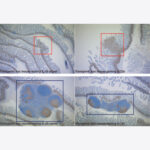
Andrew McKenzie’s group, in the LMB’s PNAC Division, has found a link between tumour-related expression of the IL25 gene, innate lymphoid cells and reduced survival amongst colorectal cancer patients
MRC Laboratory of Molecular Biology
One of the world's leading research institutes, our scientists are working to advance understanding of biological processes at the molecular level - providing the knowledge needed to solve key problems in human health.